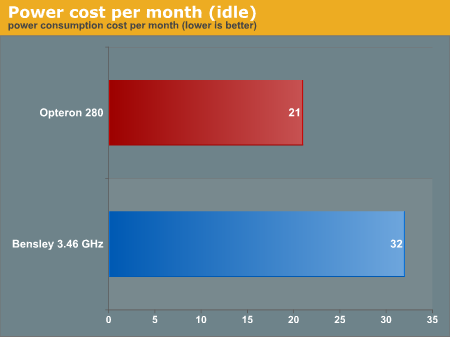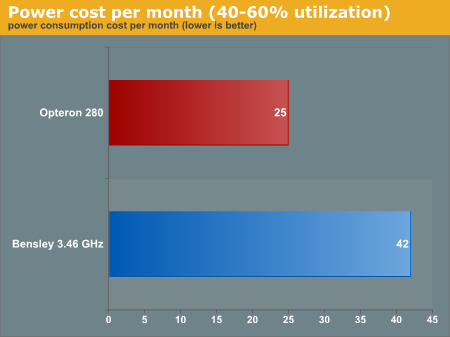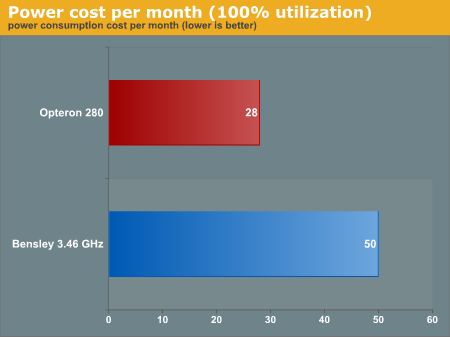Intel’s Dual-Core Xeon First Look
by Jason Clark & Ross Whitehead on December 16, 2005 12:05 AM EST- Posted in
- IT Computing
How does power consumption affect the bottom line?
We've illustrated each system's power consumption levels at different load levels. For the technical folks, those numbers are important. But, for the platform decision maker, the CTO, Director of Technology and any person in a role that looks at the bigger picture, it's important to illustrate how it affects the bottom line. Obviously, if you use more power, it costs you more money. To illustrate this, we used a current rate of 14 cents per kWh, which was taken from a power bill of a resident in Connecticut, New York. We then used the data to extrapolate the cost of each platform at the various load levels.
At 40-60% load, it costs $42 a month to run a Bensley system while an Opteron system would cost $25. Factor that over a year, and a Bensley system would cost $504 to run and an Opteron would cost $300. Now, if that doesn't pique your interest, let's say that you have 40 servers at a datacenter, with the same power characteristics. Over a year, it would cost you $8,160 more to run the Bensley system.
So, you've read through the article and are waiting for us to tell you what platform is better. That entirely depends on what matters to you: performance, power, or both. If all you care about is performance, then Bensley is that platform. If you care about how much power you consume, then Opteron is that platform. Now, if you want the best performance per Watt, then Opteron is that platform. At least that is what the database test results that we've shown here dictate. Obviously, given Intel's roadmap, they are developing platforms to address performance per Watt. Woodcrest will be the first product that is focused on performance per Watt, which we will see in the second half of 2006. Until then, the choice is yours.
We've illustrated each system's power consumption levels at different load levels. For the technical folks, those numbers are important. But, for the platform decision maker, the CTO, Director of Technology and any person in a role that looks at the bigger picture, it's important to illustrate how it affects the bottom line. Obviously, if you use more power, it costs you more money. To illustrate this, we used a current rate of 14 cents per kWh, which was taken from a power bill of a resident in Connecticut, New York. We then used the data to extrapolate the cost of each platform at the various load levels.
At 40-60% load, it costs $42 a month to run a Bensley system while an Opteron system would cost $25. Factor that over a year, and a Bensley system would cost $504 to run and an Opteron would cost $300. Now, if that doesn't pique your interest, let's say that you have 40 servers at a datacenter, with the same power characteristics. Over a year, it would cost you $8,160 more to run the Bensley system.



So, you've read through the article and are waiting for us to tell you what platform is better. That entirely depends on what matters to you: performance, power, or both. If all you care about is performance, then Bensley is that platform. If you care about how much power you consume, then Opteron is that platform. Now, if you want the best performance per Watt, then Opteron is that platform. At least that is what the database test results that we've shown here dictate. Obviously, given Intel's roadmap, they are developing platforms to address performance per Watt. Woodcrest will be the first product that is focused on performance per Watt, which we will see in the second half of 2006. Until then, the choice is yours.










67 Comments
View All Comments
OrphanBoy - Friday, December 16, 2005 - link
Ok, I haven't got one of these new chips, but my work machine that I'm sitting at right now has 2x3.6GHz Noconas with a 7800 GTX and I often run it at full whack - the amount of power I must be drawing has to be huge!Nearly half a kilowatt per machine is a scary thought!
Cygni - Friday, December 16, 2005 - link
Imagine a Pentium D EE on an Nvidia Intel SLI board with those quad-7800GT's from over at Toms. Maybe throw a few a nice RAID 5 array in too. Thats gotta pull down some SERIOUS wattage! Cant wait until the day that turning my gaming rig on for the first time trips my breaker, haha.Cygni - Friday, December 16, 2005 - link
Of note, these arent 64bit results. I get the feeling that 64bit linux results would favor the Opty even more.The FB-DIMM controller and use of multiple FSB's (FINALLY!!!) really boosts the performance here to serious competition levels. This box would make a serious workstation powerhouse.
But, as noted, Opty will likely have moved on quite a bit by the time this package is released. And it has better 64bit. And its platform is already available. But it is certainly interesting to see Intel really dominate a performance benchmark for the first time in a long time.
Peter - Friday, December 16, 2005 - link
>use of multiple FSB's (FINALLY!!!)... and only two years after AMD abandoned the dual-FSB approach and went HyperTransport.
For those who forget quickly :) the Athlon-MP chipset (AMD762 north) was using dual independent FSB.
Viditor - Friday, December 16, 2005 - link
A very good point...it doesn't make sense with the memory used to not use 64bit as well.
Jason, could you let us know why you used 32 bit instead of 64 bit?
Jason Clark - Friday, December 16, 2005 - link
We're going to look at 64bit in the new year. You have to realize most all of the general public running a windows 2003 server are running 32bit still. 64bit is not quite as adopted as you may think. That being said, we are going to look at 64 bit in the new year with sql 2005.Cheers.
Viditor - Friday, December 16, 2005 - link
Fair enough, and thanks for the first peek!
Enjoy your Holidays, then get out there and find us some MORE cool stuff to learn! ;)
Cheers,
Charles
Cygni - Friday, December 16, 2005 - link
Its likely what Intel let them run at the time, as i doubt they shipped Anandtech a working system for their own use. :DAlso, driver support is probably in its infancy. May not even have linux or x64 support today. Probably only Intel knows. But i think we can assume that 64bit will be similar to the current Xeons.
Griswold - Friday, December 16, 2005 - link
Opteron 280 = available now"Bensley/Dempsey" = ???
Btw, What about the Opteron 285SE at 2.6GHz that is exclusively used in the SUN Fire X4200? Should rectify the performance chart as well.
Heinz - Saturday, December 17, 2005 - link
Yes that issue also catched my eye, actually it is a little bit a apples to oranges comparision. There are systems available now set up against systems available in Q2 or even H2 next year. Quote:Well .. one should look at the AMD roadmap, what's in AMDs portfolio by then. Then you can declare a "winner" for the 2006 server market. Then the choice is really possible. Up to now there is not *any* choice. Everybody has to buy the AMD system, as the Intel is simply not available.
I know that you cannot test Socket F now, thus you end up with the next best solution, which is an Opteron 280 system, but my point is, that you should have at least mentioned Socket F. These can/may (still speculation) deliver performance increases for AMD in 2006, too.
Without that, the pure bottomline (performance) results of your article is, that a 2006 system is better than a 2005 one. Not really great news... even if it is about an Intel system being faster than AMD :)
So for more objective articles, please try to cover all point of views of the industry. Without that, bad boys might question anandtechs independency, exspecially after you were invited to a nice(?) trip to the Intel headquarter ... no offense here, just trying to make a fair comment. After all it was a nice overview over the next-gen Intel platform with a lot of information.
byebye
Heinz